
Hieronymus Bosch was a Dutch/Netherlandish painter from Brabant. He is one of the most notable representatives of the Early Netherlandish painting school. His work, generally oil on oak wood, mainly contains fantastic illustrations of religious concepts and narratives. Within his lifetime his work was collected in the Netherlands, Austria, and Spain, and widely copied, especially his macabre and nightmarish depictions of hell.

Municipal Museum Boijmans Van Beuningen is an art museum in Rotterdam in the Netherlands. The name of the museum is derived from the two most important collectors of Frans Jacob Otto Boijmans and Daniël George van Beuningen. It is located at the Museumpark in the district Rotterdam Centrum, close to the Kunsthal and the Natural History Museum.

The Wayfarer is an oil on panel painting by Hieronymus Bosch, created c. 1500. It is currently in Museum Boijmans Van Beuningen in Rotterdam. This painting is round and 71.5 cm (28.1 in) in diameter. It is one of the fragments of a partially lost triptych or diptych, which also included the Allegory of Gluttony and Lust, the Ship of Fools and Death and the Miser.

The Marriage Feast At Cana is a painting that was formerly attributed to Hieronymus Bosch. The painting resides at the Museum Boijmans Van Beuningen in Rotterdam, the Netherlands. Several copies exist of this picture. The copy in Boijmans had been considered the original. Dendrochronological analysis has proven conclusively that it cannot have been painted earlier than 1550.

Christ Carrying the Cross is a painting attributed to a follower of Hieronymus Bosch. It was painted in the early 16th century, presumably between 1500 and 1535. The work is housed in the Museum of Fine Arts in Ghent, Belgium. The painting is notable for its use of caricature to provide grotesque-looking faces surrounding Jesus.

Christ Carrying the Cross is an oil on panel painting by Hieronymus Bosch, executed in the most likely c. 1490-1500. It is at the Kunsthistorisches Museum, in Vienna, Austria.

Christ Crowned with Thorns, sometimes known as Christ Mocked, is an oil on panel painting by Hieronymus Bosch. It is held in the National Gallery in London, which dates it to around 1510, though some art historians prefer earlier dates.
Head of a Woman is a fragment of a Hieronymus Bosch painting, created c. 1500. It is currently in the Museum Boijmans Van Beuningen in Rotterdam, Netherlands. The fragment is only 13 cm tall and 5 cm wide.
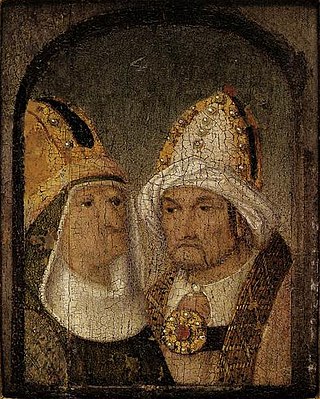
Two Male Heads is an anonymous painting formerly attributed to Hieronymus Bosch. It is currently in the Museum Boijmans Van Beuningen in Rotterdam.

Hieronymus Cock, or Hieronymus Wellens de Cock was a Flemish painter and etcher as well as a publisher and distributor of prints. Cock is regarded as one of the most important print publishers of his time in northern Europe. His publishing house played a key role in the transformation of printmaking from an activity of individual artists and craftsmen into an industry based on division of labour. His house published more than 1,100 prints between 1548 and his death in 1570, a vast number by earlier standards.

Wallerant Vaillant was a painter of the Dutch Golden Age and one of the first artists to use the mezzotint technique, which he probably helped to develop.

Concert in the Egg is a painting formerly considered to be a copy of a lost work by Hieronymus Bosch, and which is currently considered to be based on one of his drawings. Max Jakob Friedländer called it 'an old copy', without specifying another work it was copied from.
Rinus van den Bosch was a Dutch artist, who worked as sculptor, photographer, installation artist, painter, and draftsman.

The Fall of the Rebel Angels is an oil-on-panel painting of 1562 by the Netherlandish Renaissance artist, Pieter Bruegel the Elder. The painting is 117cm x 162cm and is now in the Royal Museums of Fine Arts of Belgium in Brussels, Belgium. The Fall of Rebel Angels depicts Lucifer along with the other fallen angels that have been banished from heaven. Angels are falling from the sun in a stacked manner along with ungodly creatures that Bruegel created. This piece by Bruegel was previously thought to be by Hieronymus Bosch. Bruegel was influenced by a variety of artists such as Albrecht Dürer, Frans Floris I, and Hieronymus Bosch. He also got ideas for the creation of his creatures in his previous works.
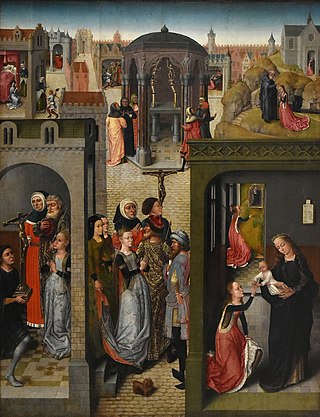
The Master of the Legend of Saint Catherine is the Notname for an unknown late 15th century Early Netherlandish painter. He was named after a painting with Scenes from the Legend of Saint Catherine, now kept in the Royal Museums of Fine Arts of Belgium. He was active between c. 1470 and c. 1500, probably around Brussels.
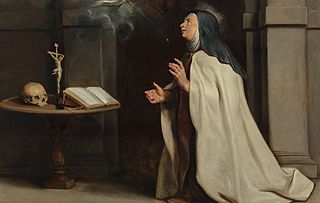
Saint Teresa of Ávila's Vision of the Holy Spirit is a 1612-1614 painting by Peter Paul Rubens. It is now in the Museum Boijmans Van Beuningen in Rotterdam.

Pieter van der Heyden was a Flemish printmaker who is known for his reproductive engravings after works by leading Flemish painters and designers of the 16th century.
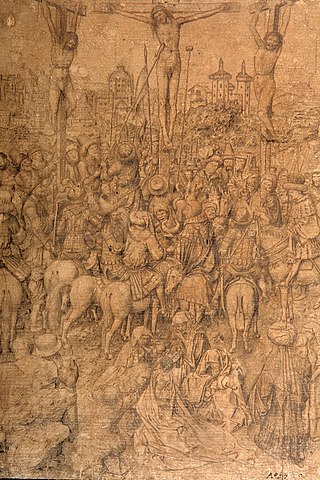
Crucifixion is a recently discovered early-15th-century drawing of the death of Jesus attributed to Jan van Eyck or his workshop, now in the collection of the Museum Boijmans van Beuningen. It is variously dated to the early 1430s, implying an original van Eyck, or c. 1440, making it a pastiche by a workshop member after Jan's death. The only other known van Eyck drawing is the Study for Cardinal Niccolò Albergati if the 1437 Saint Barbara is excluded as an unfinished painting, although there are similarities between the two; especially in its perspective, the angle of the observer's point of view, and the shadings of the rock formations. The quality of draftsmanship is of the first rate, and it is perhaps the most elaborate and complex surviving drawing from the 16th century.

The Flood Panels are two double-sided painted panels attributed to Hieronymus Bosch, dating to c. 1514 and now in the Museum Boijmans Van Beuningen in Rotterdam.
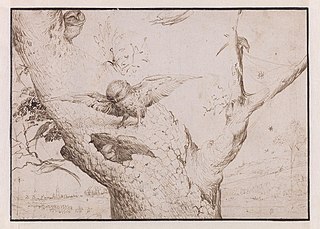
The Owls' Nest is a drawing by Hieronymus Bosch, now in the Museum Boijmans Van Beuningen.


















